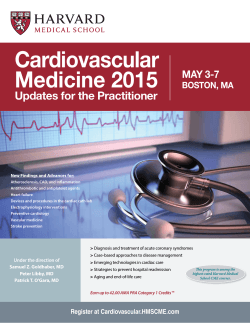
COCATS 4 Highlights - American College of Cardiology
ACC 2015 Core Cardiovascular Training Statement (COCATS 4): A New Era in Cardiovascular Training The COCATS initiative began with an ACC Core Cardiology Training Symposium held at Heart House in Bethesda, Maryland, in 1994. The seminal 1995 COCATS document went beyond the minimum ACGME training requirements for cardiovascular disease to incorporate broader input from leaders of the various components of cardiovascular medicine (Task Forces) to define the knowledge and skills expected of a clinical cardiologist and delineate progressive levels of expertise in specific areas. Subsequent revisions paralleled evolution of the field of cardiology. The latest iteration, COCATS 4, culminates a 2-year process that accumulated input from topic experts and practitioners spanning the breadth of cardiovascular medicine, and was subjected to robust organizational review as well as public comment. Here we summarize the key advances and innovations. • This comprehensive cardiovascular training statement presents the full core curriculum in a competency-based format. It embraces the 6 competency domains developed by the ACGME and endorsed by the ABIM and the ABMS. Fundamental to competencybased education is a focus on true outcomes assessments, rather than time and volume of experiences, with defined evaluation tools. For the first time, the profession has defined the core competencies expected of clinical cardiologists. • The document tabulates specific curricular competencies organized by topic within each Task Force report in a stand-alone format that can be selectively updated without awaiting revision of the entire document. This design facilitates ready access to the core curricular components in each cardiovascular subdiscipline by fellows, faculty, training program directors, and coordinators. • There is emphasis on ambulatory, preventive, and longitudinal care, including interdisciplinary and team-based care, transitions of care, chronic disease management and accommodation of comorbidities. Training requirements specifically address the important issues of appropriate resource utilization, professionalism, communication and coordination, and the care of special populations. • New task force reports define training requirements for critical care cardiology and multimodality noninvasive cardiovascular imaging, and the document incorporates important revisions regarding the variety of formats in which trainees can engage and advance in research and scholarly activity. • The curriculum provides opportunities for up to 6 months of time devoted to careerfocused elective experiences. Compared to earlier iterations, COCATS 4 contains clearer and more consistent definitions of the step-wise escalation of competency across a three-tiered structure. Level I training is required of all cardiovascular trainees. Level II competency will be mastered by many trainees based on their career focus, aptitude, and experience. Most clinical cardiovascular fellows will seek Level II independent competency in echocardiography, as ultrasound imaging has become a fundamental tool for assessment of a wide array of patients with cardiovascular diseases and conditions. Most fellows will also have an opportunity to gain a similar level of competency in one additional area of cardiovascular imaging, depending upon their interests and career goals. • Level III competency requires training beyond the standard three-year general cardiovascular fellowship. In each case, defined curricular components, milestones and outcome metrics exist to guide teachers and fellows and assure objectivity. Independent competency in more than two imaging modalities requires training beyond the standard 3-year fellowship and is usually best organized around experience in multimodality imaging. • To assist trainees and training directors, the curricular competencies specified in COCATS 4 are aligned with the ACC In-training Examination, and tools have been developed to facilitate utilization of COCATS 4 in responding to the newly required reporting milestones encompassed by the ACGME Next Accreditation System. The competencies are also aligned with and parallel (though are not identical to) the Lifelong Learning Competencies that practicing cardiologists are expected to develop and maintain. Like all educational advances, implementation of the COCATS 4 recommendations will present different challenges for each institution and training program, but the spirit of this initiative is vested in recognition of the individuality of learning. The goal is to facilitate development of the knowledge and skills all cardiologists should possess and align additional competencies with each fellow’s career focus. Medical knowledge, patient care techniques, and training methods evolve at an accelerating pace in this dynamic field, and the processes formalized in COCATS 4 define the program characteristics and requisite competencies that will better prepare cardiovascular specialists to meet the future needs of patients and society. To access the ACC 2015 Core Cardiovascular Training Statement (COCATS 4) please visit ACC.org/trainingstatements. ©2015, American College of Cardiology J1526
© Copyright 2025





















